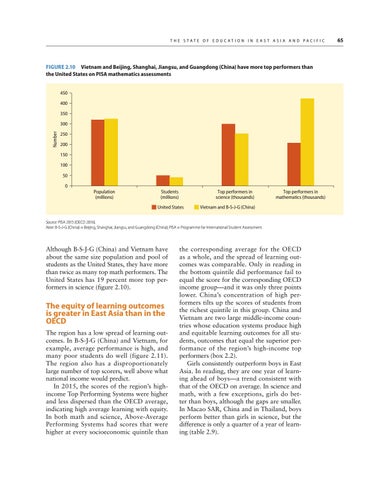T H E S TAT E O F E D U C AT I O N I N E A S T A S I A A N D PAC I F I C
FIGURE 2.10 Vietnam and Beijing, Shanghai, Jiangsu, and Guangdong (China) have more top performers than the United States on PISA mathematics assessments 450 400 350
Number
300 250 200 150 100 50 0 Population (millions)
Students (millions)
Top performers in science (thousands)
United States
Top performers in mathematics (thousands)
Vietnam and B-S-J-G (China)
Source: PISA 2015 (OECD 2016). Note: B-S-J-G (China) = Beijing, Shanghai, Jiangsu, and Guangdong (China); PISA = Programme for International Student Assessment.
Although B-S-J-G (China) and Vietnam have about the same size population and pool of students as the United States, they have more than twice as many top math performers. The United States has 19 percent more top performers in science (figure 2.10).
The equity of learning outcomes is greater in East Asia than in the OECD The region has a low spread of learning outcomes. In B-S-J-G (China) and Vietnam, for example, average performance is high, and many poor students do well (figure 2.11). The region also has a disproportionately large number of top scorers, well above what national income would predict. In 2015, the scores of the region’s highincome Top Performing Systems were higher and less dispersed than the OECD average, indicating high average learning with equity. In both math and science, Above-Average Performing Systems had scores that were higher at every socioeconomic quintile than
the corresponding average for the OECD as a whole, and the spread of learning outcomes was comparable. Only in reading in the bottom quintile did performance fail to equal the score for the corresponding OECD income group—and it was only three points lower. China’s concentration of high performers tilts up the scores of students from the richest quintile in this group. China and Vietnam are two large middle-income countries whose education systems produce high and equitable learning outcomes for all students, outcomes that equal the superior performance of the region’s high-income top performers (box 2.2). Girls consistently outperform boys in East Asia. In reading, they are one year of learning ahead of boys—a trend consistent with that of the OECD on average. In science and math, with a few exceptions, girls do better than boys, although the gaps are smaller. In Macao SAR, China and in Thailand, boys perform better than girls in science, but the difference is only a quarter of a year of learning (table 2.9).
65
